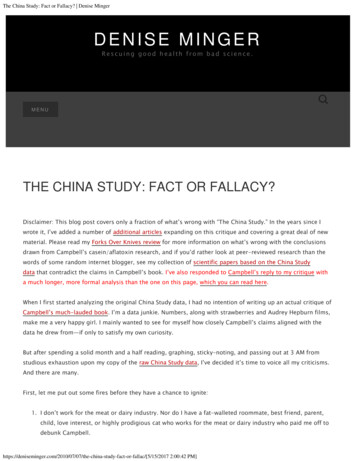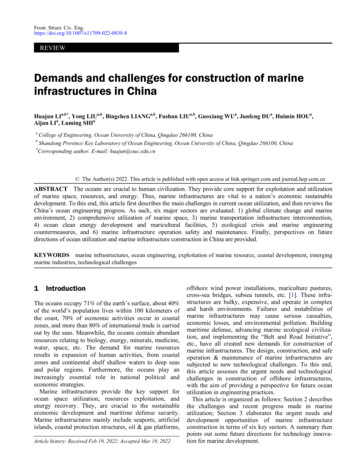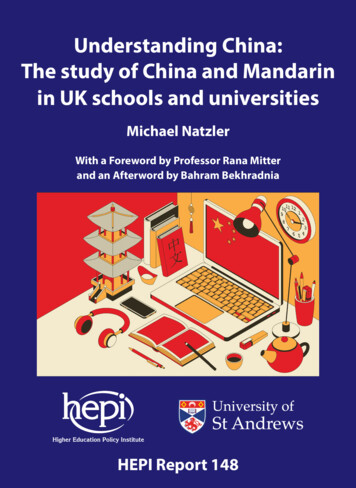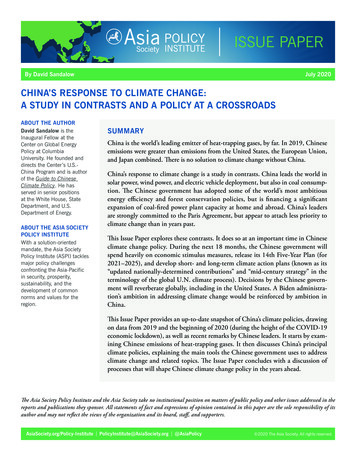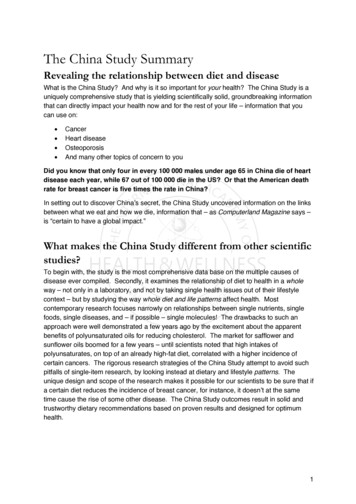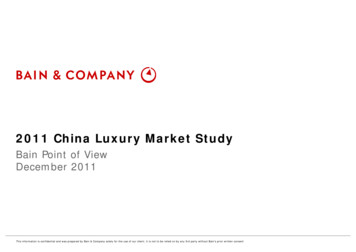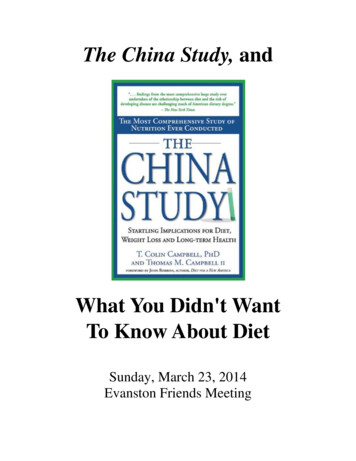
Transcription
The China Study, andWhat You Didn't WantTo Know About DietSunday, March 23, 2014Evanston Friends Meeting
-2-Table of ContentsWhy this talk? . 3What is The China Study? . 4What was the China Project? . 5Who led the China Project? . 6Who is T. Colin Campbell, Ph.D. . 7Why was the China Project done? . 8How was the China Project done? . 10Project results. 11The China Project's surprising results . 12Surprising results from supporting studies . 13Other myths busted . 15That word we hate: "Vegan" . 16Is the China Project proof? . 17What would it take to have proof? . 18The three stages of cancer . 19In the absence of proof, what do we do? . 20"But where do I get my protein?" . 22Breast cancer. 24Heart disease . 25Diabetes . 26Osteoporosis . 28Other diseases and conditions . 29Environmental reasons to consider a WFPB diet . 30Criticism of The China Study . 32Praise for The China Study . 33Disadvantages of the WFPB diet . 34Advantages of the WFPB diet. 35Why was I open to believing something so radical? . 36
-3-Why this talk? I'm not a scientist, no degree in nutrition I thought I knew about nutrition. Massive amount ofscience has disproven what I thought I knew You're busy people, lots to read If it's correct, it could save your life May help you eat healthier, be healthier(HRM) Pertinent to current healthcare debate Pertinent to climate change Unexpected deaths of friends The book is helping Paul and me –more energy, Paul's asthma gone, my cholesterol undercontrol Complex book on a complex topic – try to hit only mainpoints that struck meLoaner copies of TCS and Fuhrman's bookPrintouts of articles and things from the book
-4-What is The China Study? Book by T. Colin Campbell, Ph.D., and his son, Tom, anM.D., published 2004 Discusses1. "the China Project" (The China-Oxford-CornellStudy on Dietary, Lifestyle and Disease MortalityCharacteristics in 65 Rural Chinese Counties)2. hundreds of other studies 36 pages of notes citing studies
-5-What was the China Project? Large observational study in rural China in 1980sDraws inferences about the possible effect of a treatmenton subjects, where the assignment of subjects into a treatedgroup versus a control group is outside the control of theinvestigator.Different from experiments where subjects are randomlyassigned to a treated or group control. Jointly funded by Cornell, Oxford, Chinese Gov't The most comprehensive study of health and nutrition everconducted "The Grand Prix of epidemiology" – New York Times
-6-Who led the China Project?LEADER: T. Colin Campbell, Prof.Nutritional Biochemistry, CornellJunshi Chen, Deputy Dir., Instituteof Nutrition and Food Hygiene,Chinese Academy of PreventiveMedicineSir Richard Peto, University ofOxfordLi Junyao, China Cancer Institute
-7-Who is T. Colin Campbell? Grew up on a dairy farm M.S. Nutrition and Biochemistry,Cornell, 1957 Ph.D. Nutrition, Biochem. &Microbiology, Cornell, 1962 Research at MIT, isolated dioxin (Agent Orange) Ran lab at Virginia Tech 70 grant-years of peer-reviewed research funding 300 research papers Estimates 70% drop in America's medical costs if we allwent on a plant-based diet
-8-Why was the China Project done? 1980: Dr. Junshi Chen did research sabbatical inCampbell's lab Chen had shown effect of nutrients on rare heart conditionin children During Chen's sabbatical, China released Atlas of CancerMortality in the People's Republic of China Chinese Premier Chou En Lai gotcancer, not well understood Government of China sponsored largestsurvey of disease mortality everundertaken Death rates from 48 diseases 880 million people (96% of population)(continued)
-9-Impact of Atlas on Campbell and Chen Atlas: in China, cancer was geographically localized Cancer in the US is not Why the difference? US: Differences would be 2-3 times China: Cancer rates different by more than 100 times Most Chinese same genetic group ("Han"), sodifference not genetic. Idea to do a study of human nutrition and disease Invited Atlas's author, Dr. Li Junyao, to join Invited Sir Richard Peto, Oxford, to join Peto and Sir Richard Doll, also of Oxford, reviewed22 studies for US Congress which estimated geneticsonly responsible for 2-3% of total cancer risk.
- 10 -How was the China Project done? 1983-84 100 people in each of 65 rural counties (total 6500) Ages 35 - 64, half male, half female Blood tests Urine tests Dietary questionnaires What families ate for 3 days was measured Foods in marketplaces analyzed for nutrient content 367 variables, each compared with every other China Project results correlated with Atlas from 1973-75
- 11 -China Project published resultsPublished as monograph 1990 cofunded by the universities andgovernments involvedAvailable for purchase, expensiveExtremely technicalWorld's scientists began to studycorrelations
- 12 -Why China was the perfect choice In rural China, most people didn't move around much Diet varied greatly from one village to another – somevillages ate lots of animal products, others none at allThe China Project's surprising results Geographic localization was due to diet and lifestyle People who consume animal-based foods have more riskof disease while the opposite is true of those whoconsume more plant-based foods. Animal protein correlates with disease, not just animal fat When every disease rate was compared with every otherdisease rate, two groups of diseases emerged –assumption that each group shares common causesDiseases ofAffluence(nutritionalextravagance)Diseases of Poverty(nutritionalinadequacy and poorsanitation)Cancer (colon, lung, breast, leukemia,childhood brain, stomach, liver),diabetes, coronary heart diseasePneumonia, intestinal obstruction,peptic ulcer, digestive disease,pulmonary TB, parasitic disease,rheumatic heart disease, metabolic andendocrine disease other than diabetes,diseases of pregnancy, and many others
- 13 -Surprising results from supporting studies China Project subjects ate 30% more calories andweighed 20% less than average Americans, adjusted foractivity of lifestyle. (TCS p.99) Mechanism of action:Eating only plant protein, the body releases extra caloriesas heat, doesn't store as fat. (Campbell, 1999, inToxicological Sciences.) Casein, the protein in cow's milk, is a carcinogen. (Seedetailed description of studies in Chapter 3, TCS.) Diet can turn cancer on and off. Studies with rats fed ahigh-animal-protein diet that initiated tumors, which thendisappeared when the rats were switched to a plant-baseddiet. The rats were switched back to animal protein, thetumors reappeared. The rats were switched back again to aWFPB diet and the tumors disappeared again. Eating a plant-based diet gives you more energy, not less.Studies with rats showed an increase in exercise wheel useon a plant-based diet. Carroll study shows higher animal fat intake associatedwith increased breast cancer mortality, and increase isn'tassociated with plant fat intake. (Charts in a minute.)(continued)
- 14 3 studies on bone fractures (putative osteoporosis)(Hegsted, Abelow et al, and Margen et al) show higherbone fracture rates with calcium from animal sources. Cleveland Clinic study shows reversal of advanced heartdisease among 18 seriously ill patients consuming a plantbased, low-fat diet 1946 Morrison study, 100 heart attack survivors, odds ofsurviving 12 years were far higher on low-fat diet. Studies in 1980s by physicians Diehl, Goldhamer, Klaper,McDougall, Ornish, and Shintani Studies since TCS was published by physicians T.Barnard, N. Barnard, Corso, Fuhrman, Lederman,Montgomery, Popper, Pulde, Schulz, Shewman, and others
- 15 -Other myths busted Fiber does more than keep you regular. It "pulls waterfrom the body into the intestines to keep things movingalong. These undigested fibers, like stick-um paper, alsogather up nasty chemicals that find their way into ourintestines and that might be carcinogenic. . . .[Constipation-based diseases] include large bowel cancer,diverticulitis, hemorrhoids and varicose veins." – info fromProf. Denis Burkitt, Trinity College, Dublin, winner ofBower Award (TCS p. 89) Olive oil isn't "good for you." It's fat, no significantnutrients. The so-called "Mediterranean diet" isn't good for you(high in fat, low concentration of nutrients). Based onpeasants doing hard physical labor, early 20th Century. Some overweight people are actually malnourished.Eating empty calories, craving nutrients.
- 16 -That word we hate: "Vegan" "Vegan" has bad connotations I thought "vegan" was response to animal rights (not always!) unscientific and extreme (not true!) bad-tasting or bland food (not the way I cook!) Technically "vegan" is a reaction – No animal products "Vegan" says nothing about what you're going toward Health through nutrients "Whole Foods Plant-Based" diet the goal"Whole Foods Plant-Based Diet"(WFPB – "wofe-pub"?)
- 17 -Does the China Project offer proof thateating animal protein causes disease? NO! In human nutrition studies, proof isn't possible.Why not? Human nutrition has too many variables.A FEW (SIMPLIFIED) NUTRITION ydrates"Macro" because we Fatneed a lot of themWaterHow necessaryEssential for life"Micronutrients"Essential to avoiddisease (Example:Vitamin C, scurvy)Essential to avoiddisease (Example:Iron, anemia)Optional. Preventor reverse disease(more in a minute)Vitamins"Micro" becauseamounts needed are Mineralstiny by comparisonPhytonutrients(phyto plant)(10,000 so far) Carotenoids Chlorophyll &Chlorophyllin Curcumin Fiber Flavonoids Garlic Indole-3-Carbinol Isothiocyanates Lignans(phytoestrogens) Phytosterols Resveratrol Soy Isoflavones(phytoestrogens)
- 18 -What would it take to have proof?Knowing: exactly how many/how much of 10,000 nutrients we hadconsumed how each nutrient interacts with each of the others an unknown number of genetic factors an unknown number of other environmental factors (airpurity, water purity, etc.)
- 19 -One Reason Phytonutrients Are Important:They Can Sometimes Reverse Cancer Three Stages of Cancer:Initiation, Promotion, Progression Metaphor: growth of a lawnStageInitiationSeeding thesoil for alawnPromotionGrass growsProgressionGrass takesoversidewalk,driveway("Metastatis")How it happensWho andwhenExposed to carcinogens, which Probablygenetically transform normaleveryonecells into cancer-prone cells,damaging DNA. Affected byCan be quickprotein intake. (TCS p.51ff)UsuallyirreversibleFoci grow into tumors. "FociReversibledevelopment was almostdepending onentirely dependent on howconditionsmuch protein was(TCS p.50)consumed ""Advanced cancer cellsIrreversibleprogress in their growth untilthey have done their finaldamage." (TCS p.50)
- 20 -In the absence of proof, what do we do?1. We use correlations2. We look for mechanism of action3. We do metanalysis1. We use correlations.Example #1: We don't smoke, without proof that smokingwill kill us Correlation between smoking cigarettes and disease (heartdisease, stroke, lung cancer, emphysema, etc.) If you smoke cigarettes, odds of dying of a related diseaseare one-third This isn't proof that if you smoke, you will dieExample #2: We wear seat belts, without proof they willsave our lives Correlation between wearing seat belts and surviving acrash If you wear a seat belt, your odds are 50% better ofsurviving a crash This isn't proof that if you wear a seatbelt, you will surviveThe China Project produced over 8,000 statistically significantcorrelations. (Less than 5% probability that it's due to chance.)(TCS p.40)
- 21 2. We look for mechanism of action.Two things are correlated in a significant way when there is amechanism of action (the process by which something works inthe body) that can explain the correlation.Example A:There are more telephone poles in the US than there are inUganda.There is also more heart disease.Are telephone poles and heart disease correlated?No, because no research has shown that telephone polesaffect heart disease – no mechanism of action.Example B:More people who smoke cigarettes die of lung cancerthan in the general population.Are smoking and lung cancer correlated?Yes, because research has shown that smoking changescells in the body so that cancer is initiated – there is amechanism of action to explain it.3. We use metanalysis.We look at additional studies that come to similar conclusions,which add weight to the correlations.
- 22 -"But where do I get my protein?""Nothing has been so well hidden as the untold story of protein."(TCS p.27)A FEW FACTS ABOUT PROTEIN Hundreds of thousands of kinds of protein "The human body can derive all the essential amino acidsfrom the natural variety of plant proteins that we encounterevery day." (TCS p.31) Amount needed: 48 – 56 grams/day at a healthy weight If 2000 calories/day 11% of calories from protein Average American gets 17% of calories from protein Why? Belief in importance of "high quality" protein,probably enforced by food industries So-called "high-quality" protein from animals contains fatand cholesterol, which correlate with diseases of affluence Olympic gold-medalist Carl Lewis: "My best performanceswere when I was 30 years old and I was a vegan /vegetarian."
- 23 -How can animal protein cause disease?(Recommended reading: "The Mystique of Protein" atNutritionStudies.org, Dr. Campbell's website)Mechanism of action: Protein from animals increased body growth rate cancer cells grow faster aging speeds up girls mature younger, more estrogen, eventuallyelevated risk of breast cancer
- 24 -Some study results I found shocking1. Breast CancerMortality rate: 5 times higher in the US than in ChinaSee TCS for all 3 charts related to this studyCorrelation between breast cancer and animal fatSource: "Fat and Cancer," study by Prof. Ken Carroll (Univ. of Western Ontario),Braden, Bell et al, published in Cancer 58 (1986): 1818-1825.
- 25 -2. Heart DiseaseMortality rate: 17 times higher in the US than in China Correlation circa 1955 between animal protein and deathfrom heart disease among men age 55-59 in 20 countriesSource: Jolliffe and Archer."Statistical associations between internationalcoronary heart disease death rates and certain environmental factors."Journal of Chronic Disease 9 (1959): 636-652.
- 26 -3. Diabetes, Type 1Type 1 diabetes is 36 times more common inFinland (where they drink lots of cow's milk)than in Japan (where they drink almost none). Correlation circa 1990 between cow's milk consumption bychildren age 0-14 and type 1 diabetesSource: Dahl-Jorgenson, Joner, Hanssen. "Relationship betweencow's milk consumption and incidence of IDDM in childhood."Diabetes Care 14 (1991): 1081-1083.
- 27 -Diabetes, Type 2 See chapter 7 of TCS for detailed descriptions of numerousstudies Example: Anderson study, 1986 50 hospital patients, none overweight, injecting insulin 25 with Type 1 25 with Type 2 After 3 weeks on a high-fiber, high-carbohydrate, lowfat diet, Type 1s able to lower their insulin medicationaverage 40% 96% of Type 2s able to discontinue insulin
- 28 -4. Bone Fractures (Osteoporosis) Correlation between animal protein and more bonefractures (putative osteoporosis). Mechanism of action:Calcium from animals acidifies the body, it takes calciumfrom bones as alkaline remedy. Calcium from plant sourcesdoesn't acidify the body.Source: Abelow, Holford, Insogna. "Cross-cultural associationbetween dietary animal protein and hip fracture: a hypothesis."Calcified Tissue International 1992: 50(1): 14-18.
- 29 -Other diseases and conditions that studiesindicate may benefit from a WFPB dietSee TCS for more information. Alzheimer's Arthritis Asthma Colon cancer Colorectal cancer Dementia Kidney stones Lupus Macular degeneration Multiple sclerosis Obesity Parkinson's Prostate cancer Rheumatoid arthritis Stroke(see correlation with Vitamin D)
- 30 -Environmental reasons for a WFPB diet Greenhouse gases. Animals raised for food produce moremethane than all the world's cars Al Gore became a vegan last fall, maybe this reason? "Livestock and their byproducts actually account for51% of annual worldwide greenhouse gasemissions." Gore: "The impact of skyrocketing meat consumption ontopsoil, deforestation, and freshwater resources – and itsproduction of global warming pollution and cardiovasculardisease – is magnified by another factor as well: ninekilograms of plant protein are consumed in the productionof one kilogram of meat protein." More energy used. Animal products need morerefrigeration than plant-based foods. "In the western US, cattle have the single most pervasiveimpact on public lands, depleting native biodiversity,increasing invasive exotics, diverting water, foulingstreams, and baring the soil." (Source: Mary O'Brien, UtahForests Program for the Grand Canyon Trust)(continued)
- 31 -Environmental reasons, cont'd Deforestation. Tropical forests replaced with fields ofGMO corn and soy laced with pesticides to feed factoryfarmed beef. Cruelty. Chickens, pigs, cows, turkeys, mistreated. Mercury. Fish now commonly contain mercury. Ocean food chain. Fish becoming depleted in oceans,undermining the ocean food chain Jonathan Gold: "People need to stop eating blue fintuna. Period. The numbers of these magnificentfish are dropping fast. If we don't stop eating themnow, we'll stop in a few years anyway because therewon't be any more." Blue fin tuna stock is down bymore than 96% from unfished levels.
- 32 -Critics of The China Study Frank B. Hu and Walter Willett, authors of a paper basedon data from the Nurses Health StudyCampbell: "The Nurses' Health Study suffers from flawsthat seriously doom its results. It is the premier example ofhow reductionism in science can create massive amounts ofconfusion and misinformation . Hardly any study hasdone more damage to the nutritional landscape than theNurses' Health Study " (TCS p.272) Loren Cordain, Prof., Dept. of Health and ExerciseScience, Colorado State Univ.: Campbell's thesis was"untenable and inconsistent with the evolution of our ownspecies."Campbell: "Diet-disease associations observed incontemporary times are far more meaningful than whatmight have occurred during evolutionary times " Dr. Eades - "Doesn't prove causation." His website sellsprotein supplements to vegetarians. Dr. Mercola – "My triglycerides rose." He doesn't describethe vegetarian diet he was on. His website sells organicbeef, eggs and other animal products. Denise Minger – food blogger, author of Death by FoodPyramid – see Dr. Campbell's article in niseminger.html
- 33 -Praise for The China Study "Any serious challenge to the 'American Diet' is bound toelicit some academic, public, and food industry opposition. the surprising data are difficult to interpret in any otherway." – Wilfred Niels Arnold, Prof. Biochemistry, Univ. ofKansas Medical Center, in a book review in Leonardo "Our studies show that simple changes in diet and lifestylecan have a powerful effect not only in preventing diseasebut can reverse even severe coronary disease. we canhave a hard time believing that simple changes we make inour lives each day can have the powerful effect that theydo." – Dr . Dean Ornish, Preventive Medicine ResearchInstitute, Prof. of Medicine, Univ. of California "Plaque does not develop until the endothelium, or thelining of the arteries, is injured -- and it is injured everytime people eat meat, dairy, fish, and chicken. .Cardiovascular disease is a toothless paper tiger that neednever exist. And if it does exist, it need never progress. It isa food-borne illness. Change your food, and you changeyour life." – Dr. Caldwell B. Esselstyn, Jr., surgeon andformer Olympic rowing champion "I have found my patients requiring less medication,reversing some of their complications, and even curingtheir diabetes. The effects also carried over to better controlof hypertension and high cholesterol." – Dr. DonaldForrester, more than 30 years with Kaiser Permanente
- 34 -Disadvantages of the WFPB diet More frequent grocery shopping – salad makings don'tfreeze well More time spent preparing food – fresh food usually takesmore time to prepare than "fast" or canned foods More "tooting" but less odor More pooping (less time for reading in the bathroom!) More toilet paper used Harder to find a restaurant where you can stay on the diet Transition is an adjustment, depending on what you wereeating Finding different "comfort foods" Friends thinking they need to talk you out of it
- 35 -Advantages of the WFPB diet More energy, "lighter," "spring in your step" Easier to exercise – you feel more like exercising Eating more food – lower calorie density Fewer cravings because you're full from fiber Worrying less / more peace of mind about: Cholesterol Constipation Varicose veins Calories Safety of food left out on the counter Fewer greenhouse gases produced on your behalf Animals and fish aren't driven to extinction on your behalf Your taste buds wake up
- 36 -Why was I open to believing something soradically different?In at least 4 ways in my life I'm already open to radicallydifferent thinking.MainstreamthinkingGood guys should kill badguysViolence now less violencelaterRadically differentthinkingThere are no bad guys,everyone has Divine LightViolence now moreviolence later"American dream" more is More doesn't make youbetter The more you have, the happier, it can make youhappier you aremiserable.Live simply so that othersmay simply livePeople are able to controltheir behavior. If they don'tcontrol it, they should bepunished.When we act out of shadow,we're not in control of ourbehavior. Punishment is lesseffective than helping.Life is hard because life israndomLife is hard because theDivine sends us lessons tolearn, and growth is hard
- 37 -
What is The China Study? Book by T. Colin Campbell, Ph.D., and his son, Tom, an M.D., published 2004 Discusses 1. "the China Project" (The China-Oxford-Cornell Study on Dietary, Lifestyle and Disease Mortality Characteristics in 65 Rural Chinese Counties) 2. hundreds of other studies 36 pages of notes citing studies



